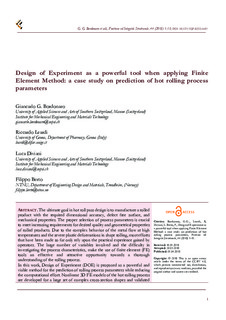| dc.contributor.author | Bordonaro, Giancarlo | |
| dc.contributor.author | Leardi, Riccardo | |
| dc.contributor.author | Diviani, Luca | |
| dc.contributor.author | Berto, Filippo | |
| dc.date.accessioned | 2019-02-25T13:04:27Z | |
| dc.date.available | 2019-02-25T13:04:27Z | |
| dc.date.created | 2018-11-22T16:31:50Z | |
| dc.date.issued | 2018 | |
| dc.identifier.citation | Frattura ed Integrità Strutturale. 2018, 12 (44), 1-15. | nb_NO |
| dc.identifier.issn | 1971-8993 | |
| dc.identifier.uri | http://hdl.handle.net/11250/2587256 | |
| dc.description.abstract | The ultimate goal in hot roll pass design is to manufacture a rolled product with the required dimensional accuracy, defect free surface, and mechanical properties. The proper selection of process parameters is crucial to meet increasing requirements for desired quality and geometrical properties of rolled products. Due to the complex behavior of the metal flow at high temperatures and the severe plastic deformations in shape rolling, most efforts that have been made so far only rely upon the practical experience gained by operators. The large number of variables involved and the difficulty in investigating the process characteristics, make the use of finite element (FE) tools an effective and attractive opportunity towards a thorough understanding of the rolling process.
In this work, Design of Experiment (DOE) is proposed as a powerful and viable method for the prediction of rolling process parameters while reducing the computational effort. Nonlinear 3D FE models of the hot rolling process are developed for a large set of complex cross-section shapes and validated against experimental evidences provided by real plant products at each stage of the deformation sequence. Based on the accuracy of the validated FE models, DOE is applied to investigate the flat rolling process under a series of many parameters and scenarios. Effects of main roll forming variables are analyzed on material flow behavior and geometrical features of a rolled product. The selected DOE factors are the workpiece temperature, diameter size, diameter reduction (draught), and rolls angular velocity. The selected DOE responses are workpiece spread, effective stresses, contact stresses, and rolls reaction loads. Eventually, the application of Pareto optimality (a Multi-Criteria Decision Making method) allows to detect an optimal combination of design factors which respect desired target requirements for the responses. | nb_NO |
| dc.language.iso | eng | nb_NO |
| dc.publisher | Gruppo Italiano Frattura | nb_NO |
| dc.rights | Navngivelse 4.0 Internasjonal | * |
| dc.rights.uri | http://creativecommons.org/licenses/by/4.0/deed.no | * |
| dc.title | Design of Experiment as a powerful tool when applying Finite Element Method: a case study on prediction of hot rolling process parameters | nb_NO |
| dc.type | Journal article | nb_NO |
| dc.type | Peer reviewed | nb_NO |
| dc.description.version | publishedVersion | nb_NO |
| dc.source.pagenumber | 1-15 | nb_NO |
| dc.source.volume | 12 | nb_NO |
| dc.source.journal | Frattura ed Integrità Strutturale | nb_NO |
| dc.source.issue | 44 | nb_NO |
| dc.identifier.doi | 10.3221/IGF-ESIS.44.01 | |
| dc.identifier.cristin | 1633936 | |
| dc.description.localcode | This work is licensed under a Creative Commons Attribution 4.0 International License. Authors are allowed to retain both the copyright and the publishing rights of their articles without restrictions. | nb_NO |
| cristin.unitcode | 194,64,92,0 | |
| cristin.unitname | Institutt for maskinteknikk og produksjon | |
| cristin.ispublished | true | |
| cristin.fulltext | original | |
| cristin.qualitycode | 1 | |

